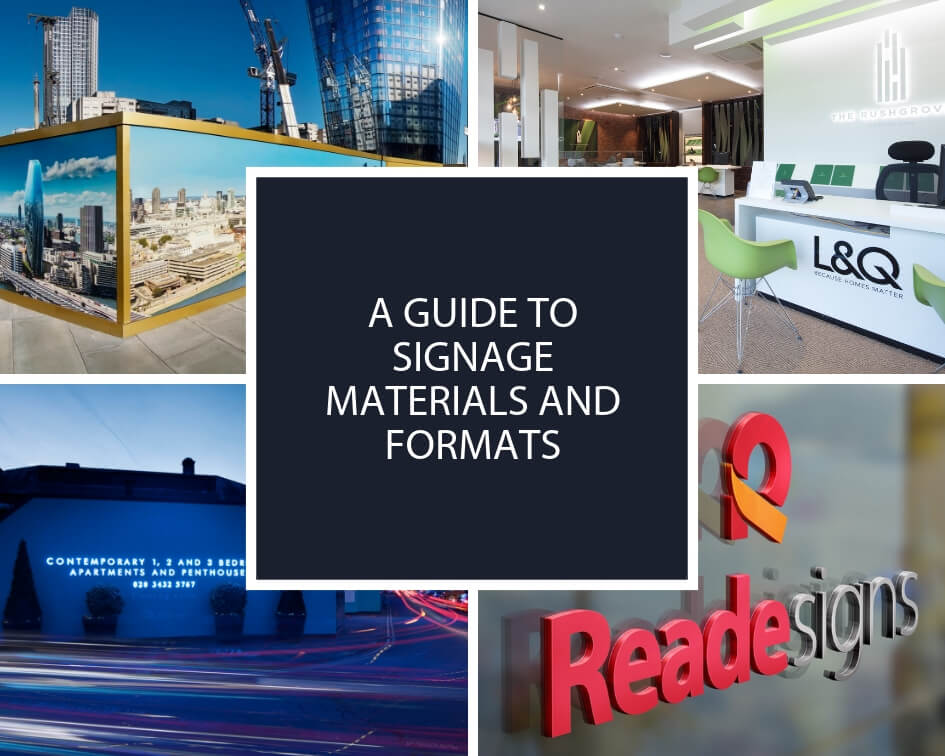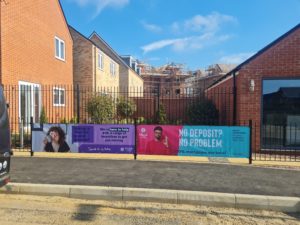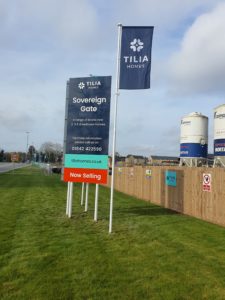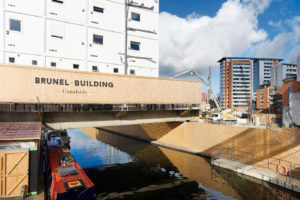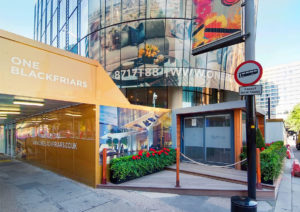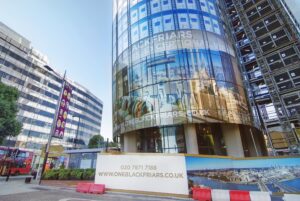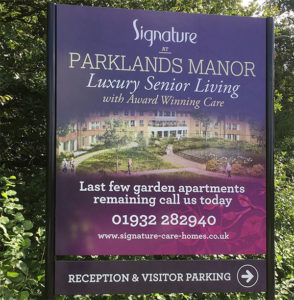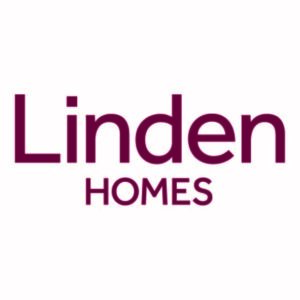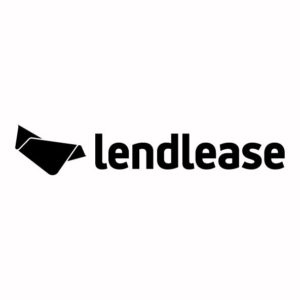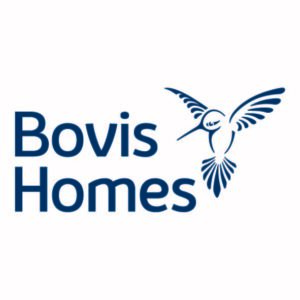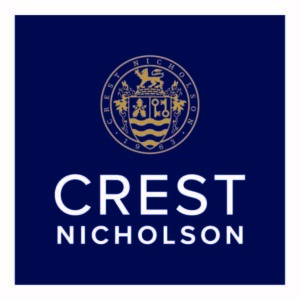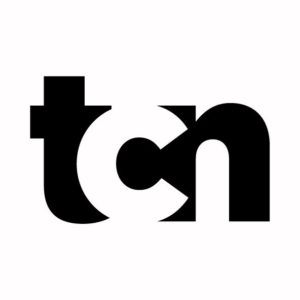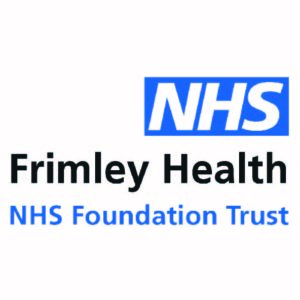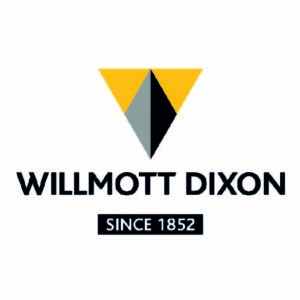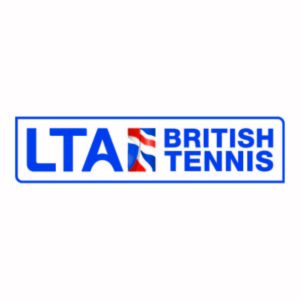Signage can be created using a wide range of materials and formats that all deliver different effects and make brands shine and messages pop out. We work with clients right from the start of each project to consult on how to bring designs to life.
Please get in touch if you have any questions or a project in mind.
Here’s a little taster of the different materials and formats on offer:
ACM clad – This stands for Aluminium Composite Material, but is also commonly known by the brand, Dibond. It’s made from two thin coil-coated aluminium sheets bonded to a non-aluminium core (polyethylene or foam). Printed ACM can be applied straight onto site hoarding to promote new developments, while adhering to health and safety regulations. It’s a superb material for hoarding because it flexes and is very durable, offers sound reduction and is fireproof. The overall affect is a streamlined, contemporary look and feel.
Acrylic – Perspex® is a well-known brand of acrylic sheeting. It is a tough, transparent, versatile thermoplastic used in many applications, particularly in visual communications, design and architecture. Acrylic is very resistant to shock, flexing, scratching and weathering. It comes in many colours and finishes and is totally recyclable. We apply acrylic shapes to hoardings to bring them to life, as well as for use in general signs and wall installations. It can be sprayed in different colours and makes brand logos stand out. We often use it self-coloured or reverse printed acrylic for stand-up letters, CGI pictures on hoardings and building exteriors.
Aluminium – A strong, light metal used widely in industry, aluminium is the most abundant metal on the planet. It’s malleable, so it’s easy to make into whatever shape we need, and it’s resistant to corrosion. We use aluminium for architectural features and walls, fingerposts, desk receptions, built-up letters and extrusions for banner frames.
Correx – Also known as fluted, or corrugated, polypropylene board, Correx is an inexpensive and efficient way to produce temporary signs or displays. Tough and lightweight, it’s easily cut to shape and comes in any number of colours and thicknesses. Correx is fully recyclable and is used a lot for outdoor signs such as estate agents’ boards.
Films and finishing – The effectiveness of our products is down to the materials and the finish we give them. Whether they need to weather gracefully to blend into a historic or rural environment or endure harsh conditions, the surface layer needs to do its job. The vinyl film or laminates that goes over our hoardings add to their longevity.
Foamex – A versatile, lightweight PVC foam sheet, that’s durable and easy to cut and shape. Foamex also has low water absorption, making it suitable for indoor and outdoor use. It comes in a range of colours and is a popular material for signage and displays. We can print directly on to foamex and it can be sprayed in different colours. We like to apply it to hoarding to bring it to life, adding a stand-out, 3D affect. We’ve even created an entire Santa’s grotto from foamex!
Glass – A hard but brittle fusion of sand, soda and lime, we’re surrounded by the many applications of glass and we use this canvas to apply graphics for signage and marketing purposes. We can create messaging on glass for marketing suites, using frosted messages, and apply crystal edge window manifestations to make subdivisions of internal spaces clearly visible.
Glass signage is also good for external architectural projects and we supply optically clear vinyl for windows. Toughened, low-iron glass is extra clear, noted for its higher light transmittance and reduced green tint. This glass is used with wayfinding architectural signage where information may change.
Graffiti proofing – We can apply a special anti-graffiti laminate seal to hoarding and signs to ensure they last. This is a special coating that makes it easier to clean your signage if it’s vandalised.
Green walls – Also known as a living wall, this is a vertical surface partially or completely covered with living greenery, complete with a growing medium and integrated watering system for interior spaces. Green walls are great especially if your external or internal space has a green and environmental theme.
Lighting – Signage can work for you 24-hours a day if it’s illuminated well. Here are some of the methods we use to spotlight your brand:
- Illuminated lettering and lightboxes – These are additional ways to light up a hoarding and highlight your key selling points. Internally illuminated, they’re hard to miss, especially at night, and colours look bright and crisp. Lightboxes, with opal acrylic inlays for exceptional illumination, can be single or double sided, wall mounted, projecting, hanging or free standing. We can even fit them to site hoarding, which we rout out and light up from behind.
- LED, ribbon or strip lighting – A flexible product, this can have self-adhesive backing for use on any surface. We use this lighting in the headers and kickers of hoarding, to accent the design and draw attention to key elements, rather than trying to light up the whole hoarding.
- Neon – These are luminous, gas-discharge tubes that contain inert gases, usually neon. Neon lighting can light up your logo or wayfinding signage in a bright and colourful way. Neon has a classic, retro look but we’ve also used it to add urban chic ambience to an ultra-modern setting.
Powder coating – This is applying paint in dry powder form to a metal surface, using a spray gun. The powder bonds electrostatically to the surface and then it’s heat treated to produce a tough coating that looks like a traditional liquid paint finish, but it doesn’t run and it’s more environmentally friendly. Powder coating is good on wayfinding signage because it’s both protective and decorative.
Printed manifestations and digital wallpaper – These are large-scale printed materials applied to walls, glass and even floors. They act like murals and can be used to add any design to your interior. Digital wallpaper – or super graphics – is artwork printed onto large areas to transform office walls, whether to support your corporate identity or brighten up the office space with some bold pop-art.
Reflective or pearlescent vinyl – This has a base colour and an accompanying colour. It is reflective and appears glossy, so we use it for hoardings and for vehicles.
Steel and stainless steel – Strong, durable and versatile, this long-established construction material is made from mixing iron and carbon in the right proportions at high temperature, but other additives give it particular qualities. Adding chromium creates stainless steel, which is highly resistant to corrosion. We use steel mainly for architectural and industrial signage, but stainless-steel fret-cut letters add an eye-catching element to signs and even hoarding.
Stone – Whether a natural-look stone or slate, we can cut it to size and shape, including bespoke lettering. This material is great for traditional architectural signage where the natural surroundings can blend around it. Stone signage also gives a sense of permanence and solidity to any environment.
Textured wall coverings – A technical name for wallpaper, it adds depth and interest with a huge range of aesthetic looks and feels. It’s tactile, encouraging interaction, so it works well in marketing suites.
Verometal – A thin, metallic coating containing bronze that’s sprayed onto a surface, verometal gives your signage the appearance of solid metal. We can create a matt, satin polished, high polished, rusted or patinated look to fit your requirements. Verometal is ideal for wayfinding and permanent outdoor signage.
Vinyl and painted wall graphics – These can be used to create bright, colourful and creative designs. They are adhesive, and can be applied directly to walls so we mainly use them for internal branding and wayfinding.
Vinyl wrapped ply – This can be added to hoarding to make it more rigid and it is popular for luxury building developments.
Vitreous enamel – This is made by fusing powdered glass to a surface by firing at high temperatures and can be opaque or coloured. The technique is more than a century old and has immortalised London street names as well as London Underground’s signage. Vitreous enamel is ideal for exterior heritage signage, standing the test of time beautifully.
Wind mesh PVC – Perforated PVC is used to make wind mesh banners. There are tiny holes in its fabric to avoiding wind damage, so it’s ideal for advertising large, new-build developments, such as apartment blocks.
Wood – Good quality wood can have excellent durability and looks high-end, ageing well when looked after. We use wood when it’s important to match the surroundings, such as the ply plaques we installed for a wetlands project. Timber frames are also used for gantry signs.
3D models – working with 3D technology specialists, we can develop a 3D printed masterplan to showcase housing projects. These are made from resin and printed through a process known as stereolithography (SLA). They depict with great accuracy a 3D visualisation of a new development for use within sales and marketing suites.

